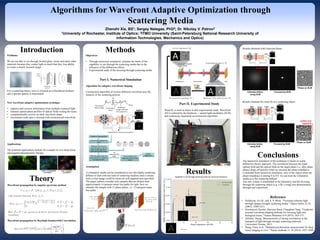Report
Share
Download to read offline

Recommended
Recommended
It is every minute detail about spectroscopy PPT ABOUT SPECTROSCOPY Spectroscopy is the study of the absorption and emissi...

PPT ABOUT SPECTROSCOPY Spectroscopy is the study of the absorption and emissi...pawansinghshrinet789
More Related Content
What's hot
What's hot (20)
17 Forensic Science Powerpoint Chapter 17 Microanalysis Of Exam

17 Forensic Science Powerpoint Chapter 17 Microanalysis Of Exam
Basics of light microscopy and imaging sonderheft_olympus

Basics of light microscopy and imaging sonderheft_olympus
Similar to ITMO Poster_Zhenzhi
It is every minute detail about spectroscopy PPT ABOUT SPECTROSCOPY Spectroscopy is the study of the absorption and emissi...

PPT ABOUT SPECTROSCOPY Spectroscopy is the study of the absorption and emissi...pawansinghshrinet789
Similar to ITMO Poster_Zhenzhi (20)
PPT ABOUT SPECTROSCOPY Spectroscopy is the study of the absorption and emissi...

PPT ABOUT SPECTROSCOPY Spectroscopy is the study of the absorption and emissi...
NIR Three dimensional imaging of breast model using f-DOT 

NIR Three dimensional imaging of breast model using f-DOT
ITMO Poster_Zhenzhi
- 1. www.postersession.com Conclusions Algorithms for Wavefront Adaptive Optimization through Scattering Media Zhenzhi Xia, BS1; Sergey Nalegae, PhD2; Dr. Nikolay V. Petrov2 1University of Rochester, Institute of Optics; 2ITMO University (Saint-Petersburg National Research University of Information Technologies, Mechanics and Optics) Problems We are not able to see through frosted glass, tissue and many other materials because they scatter light so much that they lose ability to create a clearly focused image For a scattering object, wave is focused on a disordered medium, and a speckle pattern is transmitted New wavefront adaptive optimization technique • captures and extracts information from multiple scattered light • measure spatial phase profiles of optical fields exiting the tissue • computationally recover an ideal wavefront shape • micrometer-scale spot is focused with reconstructed wavefront Applications The potential applications include for example in-vivo deep tissue and targeted photodynamic therapy. Introduction Theory Wavefront propagation by angular spectrum method Wavefront propagation by Rayleigh-Sommerfeld Convolution Objectives • Through numerical simulation, estimate the limits of the capability to see through the scattering media due to the influence of the diffraction effects • Experimental study of the focusing through scattering media Part I. Numerical Simulation Algorithm for adaptive wavefront shaping Construction algorithm of inverse diffusion wavefront uses the linearity of the scattering process Methods Targeted image specified CCD provides feedback to SLM Stepwise scanning and cycle through 0 to 2pi for every single segment to determine optimal phase Store the phase when the target intensity is maximum for each element All measurements done Set the phase of the segments to their stored values Global Maximum Feedback loop for achieving inverse diffusion Results NMSE: 0,0508 NMSE: 0,0455 NMSE: 0,0463 The numerical simulation of the technique is based on scalar diffraction theory approach. The correlation between the input optical field and the optical field on the target plane (i.e. after phase plates) drops off quickly when we increase the phase retardance. Concluded from numerical simulation, only in the region when the phase retardance is among 0 to 0.9, we can treat the volumetric media as a flat scattering diffuser The new system is established in the laboratory and the focusing through the scattering object (e.g. a fly’s wing) was demonstrated through real experiment. Reference • Vellekoop, Ivo M., and A. P. Mosk. "Focusing coherent light through opaque strongly scattering media." Optics letters 32.16 (2007): 2309-2311. • Horstmeyer, Roarke, Haowen Ruan, Changhuei Yang. "Guidestar- assisted wavefront-shaping methods for focusing light into biological tissue." Nature Photonics 9.9 (2015): 563-571. • Akbulut, Duygy. Measurements of strong correlations in the transport of light through strongly scattering materials. Universiteit Twente, 2013. • Wang, Chen, et al. "Multiplexed aberration measurement for deep tissue imaging in vivo." Nature methods 11.10 (2014): 1037-1040. Assumption A volumetric media can be considered as one flat highly-scattering diffuser so that with any kind of scattering medium until a certain limit a clear image could be retrieved with targeted area specified. The paper authors consider only samples that are thicker than approximately 6 transport mean free paths for light, here we simulate the sample with 13 phase plates, i.e. 12 transport mean free paths Part II. Experimental Study Wind fly is used as object in this experimental study. Wavefront AO is realized by the hardware -- spatial light modulator (SLM) and continuous sequential reconstruction algorithm. Results obtained with Gaussian Beam Results obtained for wind fly as a scattering object